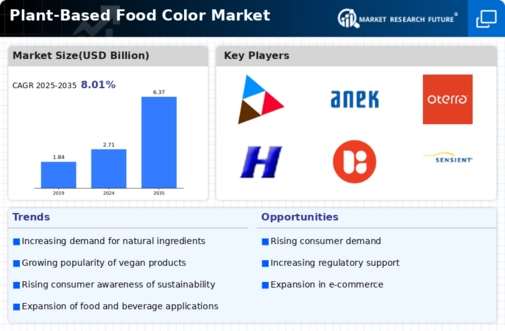Market Growth Projections
The Global Plant-Based Food Color Market Industry is projected to experience substantial growth over the coming years. The market is anticipated to reach a value of 2.71 USD Billion in 2024, with expectations of further expansion leading to a valuation of 6.37 USD Billion by 2035. This growth trajectory indicates a compound annual growth rate of 8.08% from 2025 to 2035, suggesting a robust demand for plant-based food colors driven by consumer preferences for natural ingredients and regulatory support for clean label products.
Growing Vegan and Vegetarian Trends
The Global Plant-Based Food Color Market Industry is significantly influenced by the rising trends of veganism and vegetarianism. As more consumers adopt plant-based diets for health, ethical, and environmental reasons, the demand for plant-based food colors is expected to rise correspondingly. This demographic shift is prompting food manufacturers to innovate and diversify their product offerings, incorporating vibrant plant-based colors to appeal to this growing consumer base. The market's expansion is evident, with projections indicating a value of 2.71 USD Billion in 2024, as companies strive to meet the needs of health-conscious and environmentally aware consumers.
Increased Awareness of Health Benefits
The Global Plant-Based Food Color Market Industry is experiencing growth due to heightened awareness of the health benefits associated with natural food colors. Consumers are increasingly informed about the potential risks of synthetic dyes, leading to a preference for plant-based alternatives that are perceived as healthier. This awareness is driving food manufacturers to reformulate their products, integrating plant-based colors to cater to health-conscious consumers. As the market evolves, it is expected to reach a value of 6.37 USD Billion by 2035, reflecting the growing recognition of the health advantages of natural food colorants.
Innovations in Extraction Technologies
The Global Plant-Based Food Color Market Industry is witnessing advancements in extraction technologies that enhance the efficiency and quality of color extraction from plant sources. Innovations such as supercritical fluid extraction and enzymatic processes are enabling manufacturers to obtain vibrant and stable colors with minimal environmental impact. These technological improvements not only increase the yield of plant-based colors but also reduce production costs, making them more accessible to food producers. As a result, the market is poised for growth, with a projected compound annual growth rate of 8.08% from 2025 to 2035, reflecting the potential of these innovations.
Regulatory Support for Clean Label Products
The Global Plant-Based Food Color Market Industry benefits from favorable regulatory frameworks that promote clean label products. Governments worldwide are increasingly implementing regulations that encourage transparency in food labeling, thereby fostering consumer trust. These regulations often favor natural ingredients, including plant-based colors, as they are perceived as safer and healthier options. This regulatory support is likely to propel the market forward, as manufacturers seek to comply with these standards while meeting consumer demand for clean labels. The anticipated growth trajectory suggests a market value of 6.37 USD Billion by 2035, underscoring the importance of regulatory influences.
Rising Consumer Demand for Natural Ingredients
The Global Plant-Based Food Color Market Industry experiences a notable surge in consumer preference for natural ingredients over synthetic alternatives. This shift is largely driven by increasing health consciousness among consumers, who are becoming more aware of the potential adverse effects of artificial additives. As a result, food manufacturers are reformulating their products to incorporate plant-based colors, aligning with consumer expectations. This trend is reflected in the market's projected growth, with an estimated value of 2.71 USD Billion in 2024, indicating a robust demand for natural food color solutions.



















